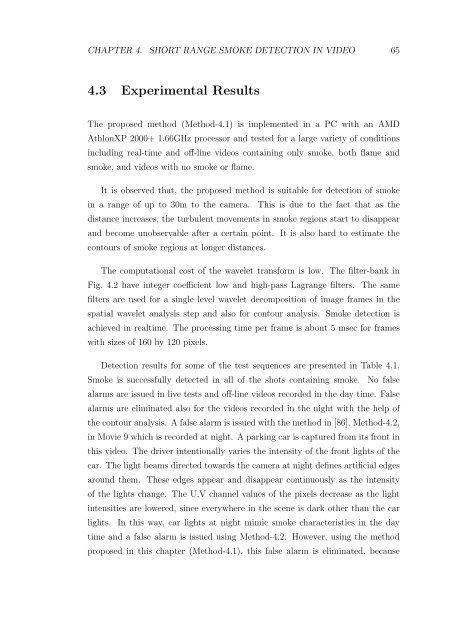Fire Detection Algorithms Using Multimodal ... - Bilkent University
Fire Detection Algorithms Using Multimodal ... - Bilkent University
Fire Detection Algorithms Using Multimodal ... - Bilkent University
Create successful ePaper yourself
Turn your PDF publications into a flip-book with our unique Google optimized e-Paper software.
CHAPTER 4. SHORT RANGE SMOKE DETECTION IN VIDEO 654.3 Experimental ResultsThe proposed method (Method-4.1) is implemented in a PC with an AMDAthlonXP 2000+ 1.66GHz processor and tested for a large variety of conditionsincluding real-time and off-line videos containing only smoke, both flame andsmoke, and videos with no smoke or flame.It is observed that, the proposed method is suitable for detection of smokein a range of up to 30m to the camera. This is due to the fact that as thedistance increases, the turbulent movements in smoke regions start to disappearand become unobservable after a certain point. It is also hard to estimate thecontours of smoke regions at longer distances.The computational cost of the wavelet transform is low. The filter-bank inFig. 4.2 have integer coefficient low and high-pass Lagrange filters. The samefilters are used for a single level wavelet decomposition of image frames in thespatial wavelet analysis step and also for contour analysis. Smoke detection isachieved in realtime. The processing time per frame is about 5 msec for frameswith sizes of 160 by 120 pixels.<strong>Detection</strong> results for some of the test sequences are presented in Table 4.1.Smoke is successfully detected in all of the shots containing smoke. No falsealarms are issued in live tests and off-line videos recorded in the day time. Falsealarms are eliminated also for the videos recorded in the night with the help ofthe contour analysis. A false alarm is issued with the method in [86], Method-4.2,in Movie 9 which is recorded at night. A parking car is captured from its front inthis video. The driver intentionally varies the intensity of the front lights of thecar. The light beams directed towards the camera at night defines artificial edgesaround them. These edges appear and disappear continuously as the intensityof the lights change. The U,V channel values of the pixels decrease as the lightintensities are lowered, since everywhere in the scene is dark other than the carlights. In this way, car lights at night mimic smoke characteristics in the daytime and a false alarm is issued using Method-4.2. However, using the methodproposed in this chapter (Method-4.1), this false alarm is eliminated, because
















